Wednesday
Community ArticlesHomeless and (Maybe) Buddhist: An Unusual Story about Going on Retreat
By: Taz Tagore
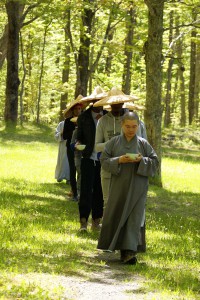 I co-founded the Reciprocity Foundation with Adam Bucko back in 2004, and almost from the outset, I wanted to take our clients—homeless teenagers and young adults living in New York City shelters—on retreat. Maybe it is because I strongly identify with homeless kids that I was sure they would love it. Or maybe I remembered how much my first retreat meant to me. Either way, I was determined to make it happen. And this past May, I was finally able to realize my longtime personal dream.
I co-founded the Reciprocity Foundation with Adam Bucko back in 2004, and almost from the outset, I wanted to take our clients—homeless teenagers and young adults living in New York City shelters—on retreat. Maybe it is because I strongly identify with homeless kids that I was sure they would love it. Or maybe I remembered how much my first retreat meant to me. Either way, I was determined to make it happen. And this past May, I was finally able to realize my longtime personal dream.
Even though I have never spent a night in a bus terminal or a homeless shelter, I have always felt emotionally displaced. My parents fled their home country months before I was born. Although I was not yet alive on the night of their escape, I grew up amidst the aftershocks of that turning point in our lives. I always lacked a strong sense of belonging—and I tried to compensate for it by being one of those people who was always ready to embrace change. And although my parents would not admit it, I know they too battled feelings of seclusion. They coped by moving my sister and I from house-to-house, year after year. At one time in my adolescence, I changed schools five times in five years.
When I went on my first 9-day retreat, I felt claustrophobic. There was no place to run and nothing to do but sit with my thoughts. What came up was sometimes poignant and sometimes scary. I spent many hours marveling at the tenderness of my own heart. But I also had to face my lifelong habit of wriggling away from anything that required true commitment. I was so afraid that I would wither away if I stayed in one place or dedicated myself to one thing. But only through going on retreat—and subsequent meditation practice—did I begin to dismantle those fears, and gradually build an organization in which I, and hundreds of homeless youth, could experience a true sense of belonging.
But as I learned last month, dreaming of going on retreat and actually going on retreat are worlds apart. Taking twelve homeless youth to a Zen-Buddhist monastery for 3 days was an experience that I could not prepare for. And while I had designed the experience for them, I too had to open myself to learning along the way. As it turned out, one of the first lessons appeared even before we left the city. 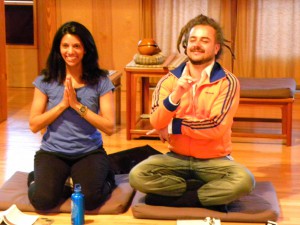
Letting Go
We had hired a school bus to drive our group upstate to the Dharma Drum Retreat Center near Pine Bush, NY. Usually when we confirm ten youth for an event, six show up. It is not that homeless teens are irresponsible—they have to juggle work, school, counseling appointments and strict curfews on empty stomachs and wallets. If they are running late, they cannot hop in a taxi or use their cell phone. Instead, they do not show up and then lay low for a few days to mask their shame. But this time, twelve youth turned up—two more than had confirmed—and several had risked losing their shelter bed to go on retreat. Even before boarding the bus, I had to let go of my expectations and embrace our over-sized group. Extra beds would be found; having too many retreatants was a good problem to have, I reasoned.
When we pulled up at the retreat center, the youth seemed energized by their surroundings. This was the first time that all twelve young people had travelled upstate. Some immediately started sneezing as their bodies adjusted to the higher pollen count. Some took off their headphones and deeply drank in the sight of trees, lavender bushes, groundhogs and a pristine lake. They seemed unsure of their surroundings, but open. I was relieved by their openness. If they could stay open, I told myself, everything would work out just fine.
When we sat down to our first silent meal, with all of us seated in rows, men facing women, I braced myself for rebellion. But the youth happily ate in silence, carefully stacked their empty plates, and some even bowed to a statue of Quan Yin before leaving the dining hall. Once outside, the youth began to walk and talk. Most gravitated to the lake and surrounding woods to make sense of their feelings. I eyed our host monastics—two radiant nuns named Chang Ji and Guo Chan—as they took in the high-decibel chatter resonating from our students. I smiled wanly. The two senior nuns had persuaded their community to host our group—it was the first time non-Buddhist, urban youth had entered the Zen monastery. And now, as the youth waded around the lake and chased each other through the pine forest, I knew I was asking them to let go of the reins a little more. I took a deep breath and exhaled. Only two more days to go.
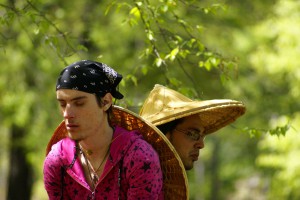
By the time night fell, many youth were itching for a cigarette, others complained of hunger and still others wanted more free time than we had scheduled in our agenda. Adam and I know enough about teenagers to know that heavy restrictions inspire insurgence; so we scrapped about two thirds of the agenda. We gave the youth more free time but, as a concession, asked them to sign up for individual counseling sessions with Adam or I. Working one-on-one with the youth would enable us to gauge their wellbeing and to coach them through any emerging emotions or traumas.
Then I skulked into the kitchen and gently inquired about adding more protein to the menu. As it turned out, the cooks had prepared fried rice and cheese sandwiches in the hopes of catering to the youths’ taste buds. But our students were accustomed to eating heavier foods such as burgers and fried chicken; to ease the transition to a vegetarian diet, they would need more eggs, tofu and tempeh. We agreed to add an afternoon snack to the menu and more complex carbohydrates to the meals. Rather than feeling insulted, the cooks were grateful for the feedback.
Later that night, I reflected on how all of the adults on retreat—staff, monastics and kitchen volunteers—had to let go of something meaningful to us—a menu, an agenda, or a preconceived idea—in order to create space for the youth to grow. Holding on would only hold the youth back, so we all learned to let go.
Cherishing Others
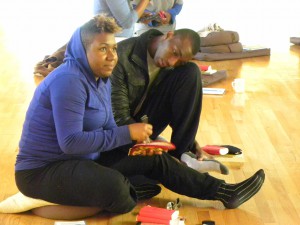
If you happen to be lucky enough to serve people in need, you know that the lines are quickly blurred between giver and receiver. My heart is always so full after I counsel a homeless youth. But I have also learned that doing more does not always lead to greater impact. It has been a tough lesson for me to learn—the quintessential “do-er” and the consummate “giver.” But in the past year, I had come close to having a nervous breakdown, and was finally forced to recalibrate my relationship to work. Now I try to do less, but with a clear intention and a pure heart.
But just before departing for the retreat, our volunteer Massage Therapist cancelled. I knew this would be a highlight for our youth—who are so rarely treated to any kind of caring touch. It was disappointing news but the gap could be easily filled by… me! I had trained in many different healing therapies over the past decade and so felt confident enough to take her place. But I worried that giving massages—on top of teaching yoga, meditation and leading Buddhist study sessions—would leave me depleted. And the last thing I wanted the youth to witness was one of their teachers falling apart.
But something had changed since my brush with breakdown—I had become a practicing Buddhist. Not the kind of Buddhist that merely floats in and out of retreats (as I had done for years) but the kind who practices everyday and is a serious student of the sutras. After I received news of the cancellation, I sat in meditation and reflected deeply on what to do. In my heart, I wanted so much to have one-on-one time with each of our students. I wanted to be able to touch them with my hands, so that they could feel my love for them. So I said “yes.” And because my decision resulted from meditation, I had a strong faith that it was the right choice.
During our first evening discussion, I offered the youth a choice between touch therapy and energy therapy. Even though students would remain fully clothed during the session, I guessed that some would prefer not to be touched at all. As it turned out, my first session was with Harmony* (her name was changed for this article), a young woman who had been sexually abused as a child and requested no physical contact.
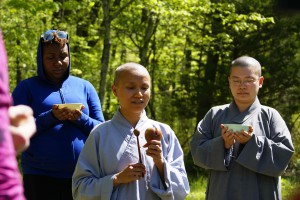
It was intimidating to work intuitively, without any physical touch to help me forge a deeper connection. But as Harmony lay down on the massage table, my heart instantly opened. I loved this student—in the three years since joining our program, I had witnessed her tackle homelessness, unemployment, mental illness, body issues and substance abuse. She had overcome all of those challenges and was now an emerging activist, leader and mentor to other youth. To me, Harmony exemplified the Buddhist principle of using struggle as fodder for spiritual advancement. She had endured so much pain and was stronger—and purer of heart—because of it.
I sat down and placed my hands beside Harmony’s head. I closed my eyes and focused my concentration on fully opening my heart. Then I invited her to breathe with me. As our inhales and exhales fell into step, energy began to flow between us. I let go of all desire to impress Harmony or to have any specific impact on her. Instead, I sent her only the purest motherly love from the depths of my heart. After ten minutes, Harmony’s breathing changed. I could tell that she had entered a state of deep relaxation. Only then did I begin to work on each of her intentions, inviting the blessings of all Buddhas and Bodhisattvas to touch her life.
At one point during the session, I felt disembodied, as though I was floating above the massage table, watching the scene unfold. I could see energy moving between us, and I was certain that it was traveling in both directions. Perhaps that is why I felt more whole in that moment than I had in a long time. It was clear that I was not healing Harmony—we were healing each other. Cherishing others, I was learning, was the surest path to becoming whole.
Radical Openness
I feel blessed to have been exposed to spiritual practice for many years, but I am no Abbot or Roshi or Geshe. Even still, I wanted to teach part of Chogyam Trungpa Rinpoche’s classic book, Shambhala: Sacred Path of the Warrior.
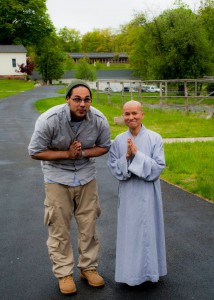
In recent years, the hip-hop community has appropriated a lot of Sun Tzu’s concepts around warrior-hood. So, I reasoned that Trungpa Rinpoche’s use of the words “Sacred” and “Warrior” would appeal to our youth. But our students are too smart to be fooled by fancy words—if I were to successfully teach, I would have to be willing to open myself, and my life, to them. In the past, I have found this to be a real challenge. I always feared that our students would neither respect nor trust me if they knew how flawed I was as an individual.
On our last evening at Dharma Drum Retreat Center, the youth gathered in Chan Hall and sat on meditation cushions that encircled a carved statue of the Buddha. We sat in meditation for a short time and then the youth assumed a more comfortable position for the discussion—lying down on the floor and propping up their arms and heads with meditation cushions. It was strange teaching a group of people who were lying down—but at least they were awake, I told myself. I outlined the game plan—I would read a few paragraphs aloud and then invite discussion from the group.
Just as I hoped, the text was accessible. We quickly entered into a heated discussion about why Sacred Warriors have a broken heart, the role of challenge in life and what it means to fully take your place in the world. But something was missing. We were all talking in the abstract—we needed to root this discussion in the reality of our own lives. But who should be the first to share?
In my life, the most compelling teachers are the ones who can teach from their own lives as well as they can teach from a text. With maturity, this has become even more important. I no longer need to place my teachers on a pedestal, elevated far from the messiness of everyday life.
So, I decided to share. I shared partly because I do not know enough Buddhist scripture to avoid talking about my own life and partly because I knew that to earn their respect as a teacher, I would need to demonstrate courage and honesty.
I told them about a part of my life that had inspired much shame and inner turmoil. Although I co-manage a homeless youth agency, I feel called to write and teach. But after my first book was published in 2005, I failed to find a publisher for the next four books I wrote. Eventually I had to let go of my renowned literary agent and I stopped writing. From a Buddhist perspective, my heart had been broken but I was not able to learn from it. I suffered from an expert’s mind; I refused to be a beginner and to start again.
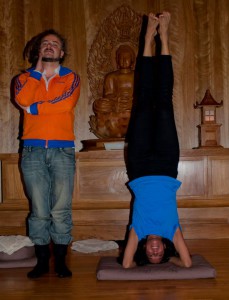
Eventually, I asked for help. I slowly figured out that the publishing world had shifted and that it was time for me to learn how to publish online. I asked someone to help me start a blog. My first posts garnered only a handful of readers. I was humbled by my paltry readership. But the process also taught me to change the way that I wrote—like most bloggers, I began to write shorter pieces, and with greater frequency than book authors. But the instant feedback of the blogosphere also helped me to dig deeper—to write with more honesty and more heart. I began to write not to demonstrate my writing skill but to share my most profound life lessons.
As I finished sharing my personal story, I could see the proverbial penny dropping in the heads of my students. My real-life experience had demonstrated why Sacred Warriors have a broken heart; it is because they are equally open to the experience of joy and suffering. Publishing my first book had raised me up and failing to publish had knocked me down—and I was venturing out again, knowing that I would surely encounter more of both. My story had also illustrated how failure had been a great teacher in my life—and why it is important to step into adversity, not turn away from it. And I hoped they could see how my relationship to my calling has changed over time. My earlier goal was to be a successful, published author; now my goal is to serve others with my writing, in any form that can reach others.
Opening myself to the youth changed the dynamic of our group. For the past three days, I had been the all-knowing teacher. Now I was just another human being—fumbling, learning and growing. After I opened myself up to the group, we came full circle. The lines blurred between teacher and student, expert and beginner—what now connected the youth and I was our shared humanity.
Inner Peace?
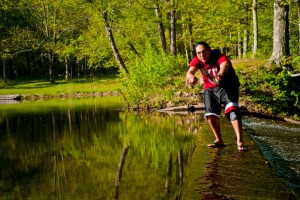
At the end of a retreat, I usually feel an inner heaviness—as though I were securely anchored to the earth’s core. My eyes are blissfully glazed over. I find it difficult to string many words together. I am prone to stare at a leaf for a very long time. I expected that some or all of these symptoms would come to light in our group. I could not have been more wrong.
Rather than finding their inner Zen master, the retreat helped our students discover their inner child. Perhaps they found the childhood that so many of them were denied as children. They began to play—running, jumping, tickling and teasing. They laughed with the giddy abandon of 11-year olds. They shed their city masks and pretenses, their solemnity, their leave-me-alone body language. The monks and nuns watched with wonder as our students brought play to their monastery, likely for the first time.
In doing so, they upturned even more of my assumptions of what it means to go within. Maybe a common response is to become a beacon of calm after a retreat—but our students taught me that there are other possible outcomes. Initially, I felt a strong pull to “act Zen.” But their joy was contagious. I too felt the desire to play, to be silly, to fully let go.
During our closing ritual, we approached each individual in the room and thanked them for something they had directly or indirectly given us: a smile when we needed it or the courage to try something new. Once again, the noise level rose substantially as words, hugs and tears passed between us. But as I gazed as the Buddha bearing witness to all of it, I could swear that his subtle smile broadened and that his laughter reverberated softly through the room.
And now that we all understood the gift of retreat, it was time to go back home.
For more information please view the following links:
www.reciprocityfoundation.org
http://vimeo.com/17831809
http://www.dharmadrumretreat.org/

















Sep 2, 2011
Reply
Every child, adolescent and young adult desearves this experience! Given freely without any dogma to be indoctrinated into them or having anything expected out of them or any hidden agendas, just the choice to go inside them selves and love! Their choice and their healing!Bravo!
Jun 23, 2011
Reply
Thank you Taz.
Your retreat experience with these kids did change hearts: theirs, yours, the nuns and monks at the monastery, and thanks to your publishing this story here, it has changed even the hearts of those of us who read about it afterwards.
It is all subtle impermanence, and out of one thing arises another thing.
Fumbling, learning, growing, or tumbling, tickling, teasing, it is all an awakening.
Thank you for this teaching.
Richard
Jun 15, 2011
Reply
I cried while reading this story. It’s a wonderful work you are doing. Thanks for sharing this.
Jun 9, 2011
Reply
Phyllis,
Thanks for your comment. There was so much to share about this retreat–that I finally decided that I could only tell my own story. Perhaps there will be room for a different piece in the future–that includes youth quotes who attended the retreat. We are creating a video which will be online by July with footage from the retreat along with clips of the youth talking about the experience as it unfolded. You can feel free to email me at [email protected] so that we can dialogue about helping in the future. We would welcome your support. Blessings…Taz
PS I’m the woman sitting on the meditation cushion in the 2nd photo, and in headstand pose in one of the last images!
Jun 9, 2011
Reply
This is a lovely story. Thank you for sharing it with us. I very much enjoyed the pictures, which are very touching. Congratulations for bringing this to fruition.
Jun 9, 2011
Reply
Thanks for this article. It is very revealing about the author mostly but also seems to be a wonderful thing to have done overall. The last line was a bit of a surprise since how do the homeless go ‘ back home’? Also, as there are no labels under the photos, is the author in one of them? Are there any plans for a follow-up with the participants? Also, who funded the retreat? Also, as a chef, I find the offering of fried rice and cheese sandwiches quite an odd unappealing combination and certainly not missing in carbs. In any case, let me know how I might be able to help you in the future. I am somewhat familiar with Pine Bush, known for it’s black soil and growing of onions, and the neighboring area of Warwick. There are lots of farms in the area, lots.
Jun 9, 2011
Reply
Thank you for this beautiful story, it was very moving!
Jun 9, 2011
Reply
Taz, thank you so much for sharing your experience of this retreat. It really touched my heart.
Julie
Jun 9, 2011
Reply
Thank you so much for this offering, Taz! Your willingness to keep your heart open created waves for all involved! Your article inspires us, your readers, to take a chance also.